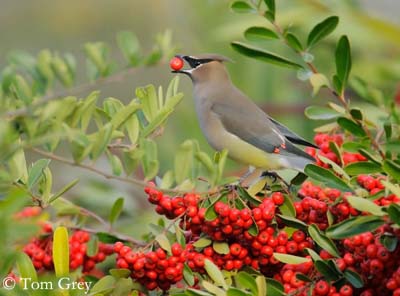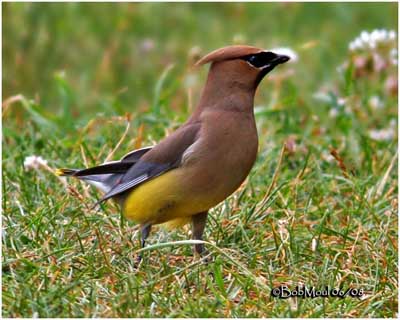
Cedar Waxwing
Bombycilla cedrorum
Passeriforme Order – Bombycillidae Family
BIOMETRICS :
Length: 14-17 cm
Wingspan: 22-30 cm
Weight: 32 g
DESCRIPTION:
Cedar Waxwing is a handsome bird, with long wings, rather short tail and beautiful crest. Bill is short and broad, legs are short.
Both sexes are similar.
PROTECTION / THREATS / STATUS:
Cedar Waxwing is vulnerable to alcohol poisoning, and may die after ingestion of fermented fruits.
Fr : Jaseur d’Amérique
All : Zedernseidenschwanz
Esp : Ampelis Americano
Ital: Beccofrusone dei cedri
Nd: Cederpestvogel
Russe: Кедровый свиристель
Sd: Indiansidensvans
Photographers:
Tom Grey
Tom Grey's Bird Pictures
René Lortie
http://rlortie.ca/
Bob Moul
Nature Photography
Texte de Nicole Bouglouan
Sources:
FIELD GUIDE TO THE BIRDS OF NORTH AMERICA - National Geographic Society - ISBN: 0792274512
A GUIDE TO THE BIRDS OF MEXICO AND NORTHERN CENTRAL AMERICA by Steve N. G. Howell, Sophie Webb - Oxford University Press - ISBN: 0198540124
A GUIDE TO THE BIRDS OF COLOMBIA by Steven L. Hilty and William L. Brown - Princeton University Press – ISBN 069108372X
Wikipedia (Wikipedia, The Free Encyclopedia)
All About Birds (Cornell Lab of Ornithology)
Animal Diversity Web (University of Michigan Museum of Zoology)
Bird Web (Seattle Audubon Society)
What Bird-The ultimate Bird Guide (Mitchell Waite)

Adults have buffy-brown head, breast and back. The brown colour turns to pale yellow on belly, to grey-brown on back, and to slate-grey on rump and uppertail coverts. Tail is barred yellow. Undertail feathers are white. Legs and feet are black.
Adults show narrow black mask bordered with white, extending from the lores to the rear of the eyes where it ends into a point. Chin is black.
Secondary feathers are tipped-red, as just dipped into red wax or paint. The English name comes from this particularity. These ornaments increase while the bird is growing up, until to get the adult plumage.
These coloured ornaments are important to find a mate.

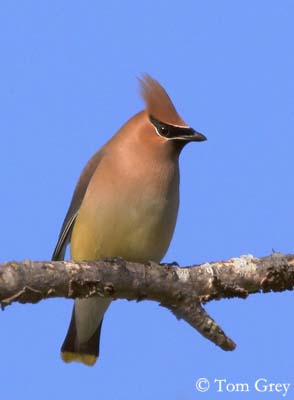
Juvenile has streaked throat, breast and flanks. Belly and undertail coverts are dull white or yellow. On the head, we can see a restricted black mask, and more white on the cheeks and the rear of the eyes.
This species breeds in the late season, and this plumage may be seen in autumn.
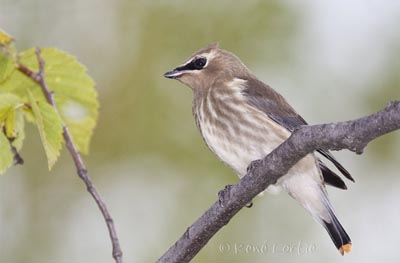
In order to compare the species, the Bohemian Waxwing is slightly larger and usually greyer.
The change of food with the Honeysuckle berries (Lonicera morrowii) which contain orange pigment, involved some changes in the plumage colour, mainly in the terminal band of the tail, turning orange instead yellow.
VOICE: SOUNDS BY XENO-CANTO
Cedar Waxwing utters distinctive calls. We can hear a buzz, a high-pitched trill “tsiii”. Pitch, duration and frequency variations are closely related to courtship, contact and begin calls.
Another common call is a high-pitched, sharp and prolonged whistle, given by the flock when they take off or land.
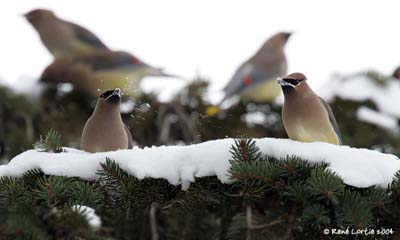
HABITAT :
Cedar Waxwing frequents open woodlands, fallow lands, farmlands, dump and urban gardens. It is absent from grassy areas and deserts, except along the streams.
RANGE:
During summer, it is found in southern Canada, from south-east Alaska and northern British Colombia to centre Ontario, and southern Quebec.
Cedar Waxwing breeds southwards in Maryland and Virginia, and in mountains, from southern to northern Georgia, from northern United States to northern California.
BEHAVIOUR:
Cedar Waxwing is very gregarious during the migrations and in winter.
It travels about 2000 km to migrate. They fly in flocks of up to 40 birds and more, while singing continuously, flying from tree to tree in winter.
In late May, pairs form in breeding areas for the season.
During the displays, the male hops laterally towards the female and offers a berry brought with the bill tip. The female takes it and performs the same game, and they repeat these displays until one of the mates eats the berry. They nest in loose bands.
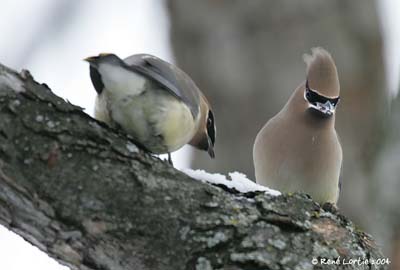
To feed, in addition to berries and fruits, adults catch insects like the flycatchers, from a perch such as dead or bare tree, or by gleaning them on leaves.
They move in flocks to find food resources. They are able to damage a whole fruiting bush in a few minutes.
When the tip of a stem offers a lot of berries, but only one bird may have an access, group’s members line up and pass the berries round from bill to bill in order to each bird can feed.
FLIGHT:
Cedar Waxwing performs powerful and direct flight.

REPRODUCTION:
Breeding season and laying occur from early June to early August, which defer the season’s end to late September-early October.
Cedar Waxwing’s nest is bulky and built by both mates. It is made with bark, leaves, grass, rootlets, moss and sometimes mud. Interior is lined with soft materials. It is placed in fruiting tree, at about 1,50 metre above the ground.
Female lays 3-5 greyish-blue eggs, spotted brown or black on the largest side. Incubation lasts about 12-14 days by female. She is fed by male during this period. He perches close to the nest in order to protect nest-site and surroundings.
Female feeds the chicks the first three days with the food brought by the male. Then, both parents rear the young.
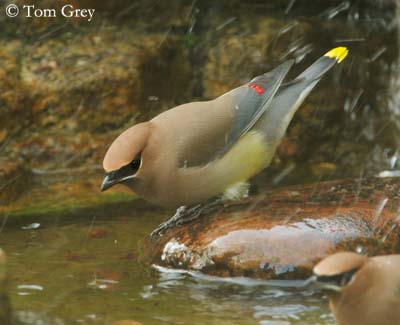
Chicks are fed first with insects, and 2-3 days later, with fruits. They are able to fly at 15 days, but they remain close to the nest and are still fed by adults for 6 to 10 days more.
They disperse one month later and join a group of juveniles, and they do not return to the nest-site.
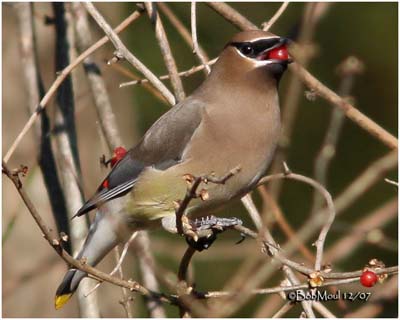

DIET:
Cedar Waxwing feeds mainly on fresh, well-sweetened fruits (70% of the diet). It also consumes insects, flowers and sap from trees. This bird is greedy!
During winter, it feeds mainly on the Cedar fruits. Since some years, it consumes more crops and ornamental plants such as wild apple-trees, hawthorn, pepper plant, olive-tree (Elaeagnus angustifolia) in the West, and honeysuckle (Lonicera morrowii) giving red rounded berries.
Whereas most of the migratory birds regurgitate seeds and stones, Cedar Waxwing excretes them by droppings about 45 minutes after feeding.
